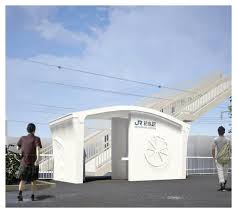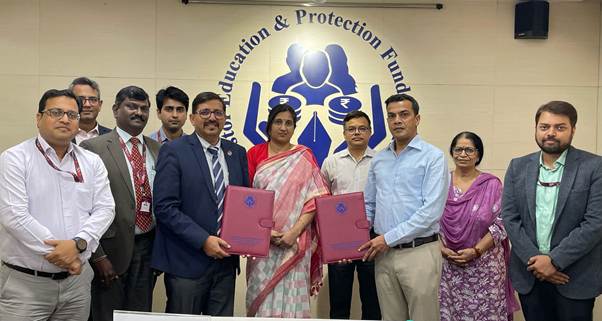World’s First 3D-Printed Train Station unveiled in Japan

- 10 Apr 2025
In News:
Japan’s West Japan Railway Company has unveiled the world’s first 3D-printed train station — Hatsushima Station in Arida city. Notably, the station was constructed in less than six hours, highlighting a major advancement in construction technology.
Understanding 3D Printing (Additive Manufacturing)
What is 3D Printing?
3D Printing, or Additive Manufacturing, is a process of creating three-dimensional objects by layering material based on a digital design. Unlike traditional (subtractive) manufacturing, which removes material, this method adds material layer by layer, ensuring reduced waste and the ability to produce complex geometries.
How 3D Printing Works:
- Design Phase: A 3D digital model is created using CAD (Computer-Aided Design) software and saved in formats like .STL or .OBJ.
- Slicing: The model is sliced into horizontal layers using specialized software.
- Printing: The printer deposits material layer-by-layer according to the sliced file. Each layer solidifies to form the final shape.
- Post-Processing: The object is finished through processes such as curing, sanding, or painting.
Major 3D Printing Technologies:
- Fused Deposition Modelling (FDM): Uses melted thermoplastic filaments to build objects layer-by-layer.
- Selective Laser Sintering (SLS): Uses lasers to fuse powdered plastics or metals into solid forms.
- Direct Metal Laser Sintering (DMLS): Employs a laser to fuse metal powders — widely used in aerospace and medical sectors.
- Material Jetting: Deposits photopolymer droplets, cured with UV light — ideal for high-precision and colorful prototypes.
Limitations of 3D Printing:
- Material Restrictions: Only specific plastics, metals, and composites are compatible with given printers.
- Size Constraints: Limited build volume necessitates assembling larger items from smaller parts.
- Structural Weakness: Objects may have weak joints due to the layered structure, reducing suitability for high-stress uses.
- IP Challenges: Digital design files can be easily shared, posing risks of counterfeiting and intellectual property theft.
Electronics Components Manufacturing Scheme (ECMS)
- 10 Apr 2025
In News:
The Ministry of Electronics and Information Technology (MeitY) has notified the Electronics Components Manufacturing Scheme (ECMS) in April 2025. It marks a strategic step in India’s ambition to become a global electronics manufacturing hub.
Key Highlights of ECMS
- Objective: To incentivize domestic production of passive electronic components and capital equipment, thus deepening India's electronics manufacturing value chain.
- Scheme Tenure: Valid for 6 years, with a 1-year gestation period.
- Focus Components: Includes resistors, capacitors, relays, switches, speakers, connectors, inductors, special ceramics, and other passive components.
- Active components are supported separately under the India Semiconductor Mission (ISM).
- Incentive Structure:
- Turnover-linked incentive (based on incremental revenue).
- Capex-linked incentive (for investments in plant and machinery).
- Hybrid model (combining turnover and capex benefits).
Incentive rates range between 1–10%, varying by year and component type.
- Employment Mandate: All applicants—whether component manufacturers or capital equipment makers—must commit to job creation, ensuring broader socio-economic benefits.
Strategic Importance
- Horizontal Sectoral Impact: The scheme is designed to support multiple sectors including automotive, consumer electronics, medical devices, power electronics, and electrical grids, promoting cross-industry multiplier effects.
- Support for Tooling & Capital Equipment Industry: Encourages design and manufacture of capital tools and machinery required for electronics production, in line with models seen under the India Semiconductor Mission.
- Global firms like Linde have begun operations, with more in pipeline.
India’s Electronics Growth Trajectory
- Export Milestone (FY 2024–25):
- Total smartphone exports: ?2 lakh crore
- iPhone exports alone: ?1.5 lakh crore
- Sectoral Growth (Last Decade):
- 5x growth in production.
- 6x growth in exports.
- Export CAGR: >20%
- Production CAGR: >17%
- Manufacturing Base Expansion: Over 400 production units (large and small) now manufacture a wide range of electronic components domestically.
- Value Chain Evolution: India has transitioned from assembling finished goods → sub-assemblies → deep component manufacturing, now entering a value-added, self-reliant phase in electronics
One State, One RRB Policy
- 10 Apr 2025
In News:
The Government of India, through the Ministry of Finance, has implemented the "One State, One RRB" policy effective from May 1, 2025, aimed at consolidating 26 Regional Rural Banks (RRBs) across 10 states and 1 Union Territory, thereby reducing the total number of RRBs to 28. This move follows the recommendation of the Dr. Vyas Committee and is intended to enhance the performance and outreach of RRBs.
Objectives of the Policy
- Improve operational efficiency and governance.
- Rationalize costs and optimize resources (human and technological).
- Eliminate intra-state competition among sponsor banks.
- Promote uniform service delivery through technological integration.
About Regional Rural Banks (RRBs)
- Established: 1975 under the Regional Rural Banks Act, 1976.
- Recommended by: Narasimham Committee (1975).
- Ownership Pattern:
- Government of India – 50%
- State Government – 15%
- Sponsor Bank – 35%
Regulatory Structure
- Regulated by: Reserve Bank of India (RBI)
- Supervised by: NABARD (National Bank for Agriculture and Rural Development)
Role and Objectives
- Provide institutional credit to rural India.
- Support priority sectors like agriculture, MSMEs, and rural artisans.
- Ensure financial inclusion among farmers, labourers, and small entrepreneurs.
Impact of the Reform
- Operational Scale: Enhanced credit delivery across wider geographies.
- Technological Standardization: Easier integration of IT infrastructure.
- Unified Governance: One sponsor bank per state improves accountability.
- Performance: RRBs recorded an all-time high net profit of ?7,571 crore in FY 2023–24.
- Asset Quality: GNPA (Gross Non-Performing Assets) stood at 6.1%, the lowest in a decade.
Poshan Pakhwada 2025 and Palna Scheme
- 10 Apr 2025
In News:
The Ministry of Women and Child Development (MoWCD) is spearheading a dual approach to address malnutrition and childcare challenges in India through two flagship initiatives—Poshan Pakhwada 2025 and the Palna Scheme under Mission Shakti.
Poshan Pakhwada 2025
- 7th edition observed from April 8–22, 2025, under Poshan Abhiyaan.
- Focuses on four key themes:
- Nutrition in the first 1,000 days (conception to age two).
- Promotion of the Poshan Tracker digital platform.
- Community-based Management of Acute Malnutrition (CMAM).
- Encouraging a healthy lifestyle to reduce childhood obesity.
- Poshan Tracker App (AI-enabled; launched in 2021):
- Registers all Anganwadi Centres (AWCs).
- Enables real-time monitoring of beneficiaries, meal distribution, and health data.
- Allows family self-registration via web.
- CMAM protocol (introduced in 2023): Empowers Anganwadi workers to detect and manage malnutrition at the grassroots.
- Special focus on tribal and remote areas, promoting awareness on breastfeeding, balanced diets, and early stimulation.
- Campaign supported by 18 partner ministries, with outreach via village camps, home visits, and awareness drives.
Palna Scheme under Mission Shakti
- Centrally sponsored scheme launched in 2022, succeeding the National Crèche Scheme.
- Operates under the Samarthya sub-scheme of Mission Shakti.
- Aims to provide quality crèche services for children aged 6 months to 6 years, especially for working mothers.
Key Features:
- Implemented by: Ministry of Women and Child Development (MoWCD).
- Funding Ratio:
- 60:40 (Centre: State),
- 90:10 for NE and special category states.
- Two crèche models:
- Standalone Crèches near homes/workplaces.
- Anganwadi-cum-Crèches (AWCCs) integrated within Anganwadi Centres.
- Facilities Provided:
- Nutritional meals, growth monitoring, immunization.
- Early stimulation and pre-school education.
- Support for continued breastfeeding.
- Crèche Capacity: Each unit supports up to 25 children.
- As of March 2025:
- 11,395 AWCCs approved across 34 States/UTs; 1,761 operational, catering to ~28,783 children.
- 1,284 Standalone Crèches operational with ~23,368 children enrolled.
- 17,000 new AWCCs planned for 2024–25.
- Legal Backing: Mandated in workplaces with 50+ employees under the Maternity Benefit Act (amended).
Significance for India
Together, Poshan Pakhwada and Palna contribute to achieving SDG 2 (Zero Hunger) and SDG 3 (Good Health and Well-being) by ensuring a lifecycle approach to nutrition and holistic early childhood care. They reflect the government's commitment to digital governance, gender empowerment, and inclusive development.
Niveshak Didi

- 10 Apr 2025
In News:
In a significant push toward inclusive financial literacy, the Investor Education and Protection Fund Authority (IEPFA), under the Ministry of Corporate Affairs, and the India Post Payments Bank (IPPB), under the Department of Posts, Ministry of Communications, have signed a Memorandum of Agreement (MoA) to launch Phase 2 of the “Niveshak Didi” initiative in April 2025.
Objective:
The Niveshak Didi initiative, launched in 2023, is a women-led, community-driven financial literacy program designed to empower rural and underserved populations by fostering responsible financial behavior, promoting digital banking, and spreading fraud awareness.
Key Highlights:
- Target Group: Rural women and semi-urban communities.
- Approach: Local women, especially postal workers, are trained as financial educators (Niveshak Didis).
- Impact of Phase 1:
- Over 55,000 beneficiaries reached, with 60% women, predominantly from deep rural areas.
- Most beneficiaries belonged to the youth and economically active age groups.
Phase 2 (2025 Onward):
- Deployment of 4,000+ financial literacy camps across rural, tribal, and semi-urban areas.
- Training of 40,000 women postal workers to serve as grassroots financial educators.
- Curriculum Focus:
- Savings and budgeting.
- Responsible investing and fraud prevention.
- Digital tools and services provided by IPPB.
- Digital Inclusion: Leveraging India Stack for paperless and presence-less banking; training delivered in 13 regional languages.
About Investor Education and Protection Fund Authority (IEPFA)
- Statutory Body: Functions under the Ministry of Corporate Affairs, Government of India.
- Objective: Ensures informed and protected investors across India.
- Key Role:
- Promotes financial literacy to aid budgeting, saving, and investment decisions.
- Empowers citizens to make sound financial choices.
- Focus Areas:
- Educates citizens on investor rights and responsibilities.
- Special outreach to rural and underserved areas to bridge financial knowledge gaps.
- Vision: To build a financially aware and confident India, where every citizen has the tools to secure their financial future.
About India Post Payments Bank (IPPB)
- Established: On September 1, 2018 under the Department of Posts, Ministry of Communications.
- Ownership: 100% equity owned by the Government of India.
- Mission: To be the most accessible, affordable, and trusted bank for the common man.
- Mandate:
- Bridge financial inclusion gaps for the unbanked and underbanked.
- Leverage the vast postal network of approx. 1.65 lakh post offices (1.4 lakh in rural areas) and 3 lakh postal employees.
- Technology Backbone:
- Based on India Stack: Paperless, Cashless, and Presence-less banking.
- Uses CBS-integrated smartphones and biometric devices.
- Commitment:
- Promotes a less-cash economy.
- Supports the vision of Digital India.
- Motto: Every customer is important, every transaction is significant, every deposit is valuable.
